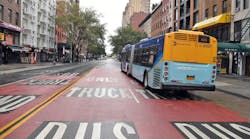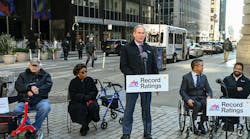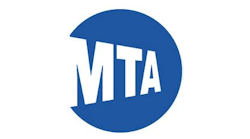NYC DOT launches plan to reimagine city's curb space
New York City Department of Transportation (NYC DOT) has launched a comprehensive effort to reimagine the city's curb space – deploying innovative tools and creative, forward-looking strategies to make the city cleaner, greener and healthier. With the explosion in home deliveries and growing range of transportation modes on city streets, curb space has become increasingly sought after, competitive, and chaotic. The Curb Management Action Plan includes 10 concrete steps to better design and manage the curb lane to reflect the increasingly wide range of needs of residents, workers, visitors, business owners and all New Yorkers.
The action plan represents another step in NYC Mayor Eric Adams administration's efforts to reimagine the use of public space, supporting the goals laid out by the New New York Panel's "Making New York Work for Everyone" action plan and Mayor Adams' "PlanNYC: Getting Sustainability Done."
"Activity on our streets is a sign of New York City's vibrancy and strong economic recovery, something that can happen safely and sustainably," said Mayor Adams. "With the Curb Management Action Plan, our administration is reimagining and better managing increasingly contested curbs to make our limited space work better for residents, businesses and visitors. This effort will advance all of our administration's work to improve New Yorkers' quality of life and deliver a more vibrant, livable city."
"This administration is reimagining the use of public space and our streets are public spaces that should benefit all New Yorkers," said NYC DOT Commissioner Ydanis Rodriguez. "The priorities in the Curb Management Action Plan will help reduce congestion, improve safety and enhance New Yorkers' quality of life. We look forward to working with communities across the city to pursue the plan's long-term goals."
The 10-point action plan includes:
- "Smart Curbs" pilot: Working with business improvement districts (BIDs) and other community partners, NYC DOT will select neighborhoods in which to reimagine curb space from scratch. In pilot neighborhoods, NYC DOT will evaluate current curb regulations, identify community needs at the curb and test new uses and technologies that make access easier – mitigating traffic congestion and double parking.
- Microhubs and loading zones, providing dedicated space for commercial vehicles to reduce double parking.
- Public space improvements, including street furniture, plantings, pop-up markets, community art, delivery worker relief stations and waste containerization.
- Expanded bike parking and corrals, in accordance with delivery worker needs.
- Prioritizing curb uses to meet neighborhood needs: Effective curb management requires prioritizing curb functions that reflect local context. NYC DOT will develop and publish a curb management hierarchy to inform the public and aid planning decisions. The guide will help prioritize curb usage across the city based on street or neighborhood styles, consistent with the city's transportation goals and needs.
- Make home and business deliveries safer, sustainable and more efficient: In response to the tremendous growth of e-commerce, NYC DOT is identifying ways to address freight-related safety, congestion, pollution and quality-of-life concerns through smarter curb management. Strategies include incentivizing off-hour deliveries, establishing dedicated loading zones and creating microhubs where goods can be transferred from larger freight vehicles to smaller low- or no-emissions vehicles.
- Pilot the east coast's first low-emission zone: NYC DOT will examine ways to require and/or incentivize the use of low- and zero-emission trucks through the creation of low-emission zones in areas with the highest concentration of truck traffic and the worst public health outcomes. A pilot program for one or more locations will be implemented in a community disproportionately impacted by climate change.
- Designate curb space to make passenger pickups and drop-offs easier: The surge in for-hire vehicle trips has created additional competition for curb space, often resulting in parking regulation violations like improperly occupying taxi stands, double parking and unsafe pickups and drop-offs. To delineate existing space more clearly, NYC DOT will establish dedicated pickup/drop-off zones for for-hire vehicles in high-volume locations. NYC DOT will also continue to work with the Metropolitan Transportation Authority (MTA) to expand loading zones for Access-A-Ride paratransit vehicles in key locations and update its parking design standards to reflect the U.S. Access Board's Public Rights-of-Way Accessibility Guidelines.
- Expand bike parking to improve convenience: Each day brings roughly 550,000 bicycle trips in NYC – more than triple the number from 15 years ago. The city has also seen a rapid increase in the use of other micro-mobility devices. In addition to installing thousands of new bike racks on sidewalks, NYC DOT is installing bike corrals in the curb lane to provide higher-capacity parking. NYC DOT will also solicit proposals for vendors to pilot secure bike parking facilities, including in the curb lane.
- Provide space for outdoor dining, waste containerization, street furniture and other public realm improvements: NYC DOT will expand use of the curb lane for sidewalk widenings, curb extensions, bus boarding platforms, plantings, public art and the Street Seats program, which creates small-scale public spaces adjacent to the sidewalk. NYC DOT will allocate curb space to support implementation of Dining Out NYC – the nation's largest outdoor dining program – and the NYC Department of Sanitation's ongoing efforts to containerize waste to improve pedestrian travel and mitigate rodents. Working with the NYC Housing Authority, NYC DOT will also provide curb space for the Clean Curbs for All pilot to use large, on-site waste containers at public housing developments, including in the curb lane.
- Test new technologies for remote and flexible curb management and enforcement: NYC DOT will pilot and implement proven and emerging technologies for more efficient, data-driven, and user-friendly curb management. This includes adopting pay-by-plate parking meters, partnering with the MTA to install enforcement cameras to discourage double parking and blocking bus stops and bike lanes and using sensors or cameras that provide data on curb usage.
- Price on-street parking to encourage commercial activity: NYC DOT will expand the use of parking meters and develop pricing mechanisms to support policy goals such as safety and sustainability. Pricing parking closer to market rates, for example, will support small businesses by improving turnover at parking meters.
- Charge for non-transportation users of curb space: The curb lane is often occupied by private uses unrelated to mobility, safety or public space. Pricing is an important tool to discourage unnecessary or excessive use of space while reflecting the high value of the curb lane. NYC DOT will develop a framework to charge more generally for street occupancy, starting by advocating for state legislation that would authorize a wider ability to price occupancy of the curb. For example, the Dining Out NYC program will allow restaurants to use the roadway for fixed per-square-foot fees, based on geography.
Curb uses may include:
The pilot will also include tests of new technologies to maximize the effectiveness of other curb management tools and most efficiently utilize curb space. One possible technology that will be tested is cameras, for example, which could help to monitor occupancy and rewrite curb regulations based on data showing when residents and businesses most often use curb space.
The Columbus Avenue BID in Manhattan will be the first "Smart Curbs" neighborhood launching this fall. Many of the densest and busiest commercial areas of the city with the greatest need for innovation at the curb have a BID that can provide local expertise and public space management. NYC DOT will use a data-driven approach with public feedback to employ new curb uses like loading zones, bike parking, carshare, public space improvements and more while deploying a demand-responsive approach to adjust parking meter rates, with the goal of improving the overall transportation experience in each area.
NYC DOT will also create a demand-based pricing pilot program that will include technology that adjusts rates in real time based on demand and the time of day. Working with the NYC Department of Finance, NYC DOT will update fine structures for curb violations to make enforcement of curb regulations more effective.





